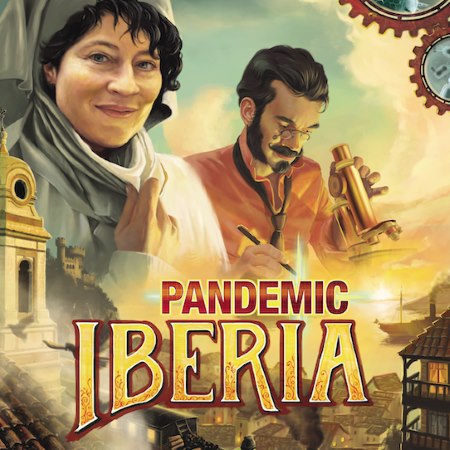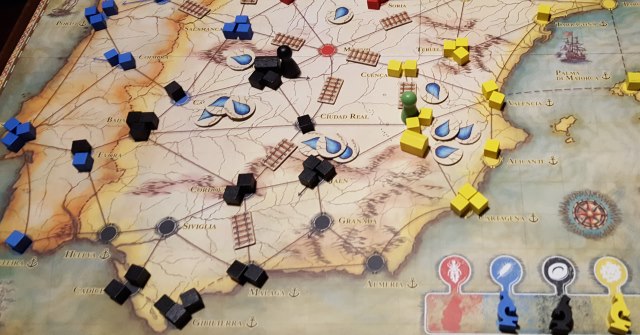
The Pandemic games have been pretty successful so far, and with good reason. A series of tricky but not unfair co-op games, the original had you trying to cure four deseases which had broken out, with various conditions which would mark your failure and therefore the impending doom of any humans nearby. It took a slight turn with Pandemic Legacy, a persistent story-based title which people still talk about as one of the better games around, and then a proper kick off-track with Pandemic: Reign of Cthulhu which we reviewed and, despite it being pretty different in theme, was still all kinds of awesome.
With the move to Iberia the latest Pandemic game is far closer to the original in terms of gameplay, but there are quite a few tweaks and differences that make it feel like it deserves its own spot in your collection. First off, the diseases you’ll be trying to cure are all well known: malaria, typhus, yellow fever, and cholera, which gives a subconscious heightened urgency, knowing that you’re dealing with real diseases that you’ve heard of and know how violent they can be. They behave in similar ways, but it’s cool to have such infamous diseases to get rid of. The map itself is based around the Iberian Peninsula which, if you’re not aware (as I wasn’t) covers the Spain and Portugal regions, and includes some pretty iconic cities such as Barcelona, Porto and Madrid. The four diseases are colour coded and linked to specific areas of the map, which in turn match the colours of the diseases, so it’s a piece of cake to follow.
Turns are similar to the other Pandemic games, whereby you have 4 actions per turn to use on movements, treating diseases or building railways. Once you’re done, you take a couple of player cards which will help you to research the diseases or carry out various other tasks, then draw some Infection cards – the number of these depends on which stage of the game you’re at and how badly things are going; there’s a track on the board which tells you how many, so you won’t lose count. The infection part of the game is always a moment to hold your breath, not knowing if it’s just going to start looking a bit dodgy or if a full on outbreak will occur which then has huge knock-on effects for cities surrounding the one you’ve just drawn.
Your player cards meanwhile can be used to purify water (which can help to prevent an area becoming more infected), share your knowledge by giving cards to other players (although there are limits to this based on your position on the board) or building a hospital. That last option is especially important because your cards can also allow you to research a disease once you have 5 of the same colour, but only if there’s an accompanying hospital to carry out the research. It’s a key thing to remember bearing in mind the only way to win at this game is to have researched all four diseases, and unlike the original game researching a disease doesn’t cure it. Instead it just helps to prevent it getting much worse, which is obviously quite a bonus, but there’s no suggestion here that you’ll be eradicating these diseases with any great ease.

So moving around to the right place is pretty important, and being set in the 19th century you won’t be finding many aeroplanes to hop onto. Luckily, boats were a thing, and you can travel from one port to another by discarding a coloured card matching the area you’d like to travel to, so it’s entirely possible to leap from one side of the map to the other in a single action. Pretty handy. You can also, as mentioned earlier, build up the railway around the map which initially doesn’t seem too valuable, but as the network grows it proves to be an invaluable option thanks to being able to use a single action while travelling as far as you want on any continuous run of track. It’s a great idea, and certainly rewards a bit of forward thinking in the early stages when there isn’t as much mess to be dealing with.
There are also several ways you can play this. There are enough different characters which different abilities to keep things interesting from one game to the next, but also some variant cards which make subtle but very noticeable changes to the game’s mechanics. The most significant of these deals with adding the movement of patients, whereby on each turn the nearest patient (designated by the cubes used when infecting a city) moves towards a hospital, right up until the moment the hospital is overrun at which point they flee, potentially sparking outbreaks or other issues in the surrounding areas. Not ideal, and adds a whole new challenge to the idea of having hospitals across the board. The other variant cards deal with making the diseases more powerful, spreading faster or whatever else, and adding one or more of these into your game before you start will give you a whole new experience on your hands.
Considering the relatively low cost of the game, this is as close to a no-brainer as you could get. Even if you own another Pandemic game there seems to be enough that’s new or different in here to warrant giving it a go. The quality of the components is every bit as good as you’d expect, and the balance seems just right in terms of it being possible to win, but the odds are definitely stacked against you. This game is cast iron proof that even losing a game can be enormously enjoyable. Very easy to recommend.
Pandemic: Iberia
Available Now, RRP £29.99
Find your local stockist here

Leave a Reply